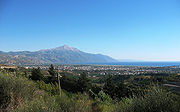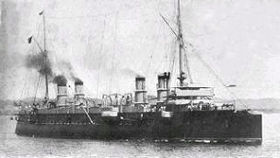
Musa Dagh
Encyclopedia

Armenians
Armenian people or Armenians are a nation and ethnic group native to the Armenian Highland.The largest concentration is in Armenia having a nearly-homogeneous population with 97.9% or 3,145,354 being ethnic Armenian....
during the Armenian Genocide
Armenian Genocide
The Armenian Genocide—also known as the Armenian Holocaust, the Armenian Massacres and, by Armenians, as the Great Crime—refers to the deliberate and systematic destruction of the Armenian population of the Ottoman Empire during and just after World War I...
. The denizens of that region were violently expelled from their six village
Village
A village is a clustered human settlement or community, larger than a hamlet with the population ranging from a few hundred to a few thousand , Though often located in rural areas, the term urban village is also applied to certain urban neighbourhoods, such as the West Village in Manhattan, New...
s (Kabusia (Kaboussieh), Yoghunoluk, Bitias, Vakef
Vakifli, Samandag
Vakıflı Köyü is the only remaining ethnic Armenian village in Turkey. Located on the slopes of Musa Dagh in the Samandağ district of Hatay Province, the village overlooks the Mediterranean Sea and is within eyesight of the Syrian border. It is home to a community of about 130 Turkish-Armenians...
, Kheter Bey (Khodr Bey), Haji Habibli) by the Ottomans in 1915. As Ottoman Turkish forces converged upon the town, the populace aware of the impending danger fell back upon Musa mountain and repeatedly thwarted assaults for fifty-three days. Allied warships, most notably French, in the Mediterranean responded to distress signals and rescued the remaining survivors just as ammunition and food provisions were being exhausted. The warships then transported them to Port Said, Egypt. A tomb exists in the city of Port Said of some martyrs of Musa Dagh.
Genocide survivors

Hatay Province
Hatay Province is a province in southern Turkey, on the Mediterranean coast. It is bordered by Syria to the south and east and the Turkish provinces of Adana and Osmaniye to the north. The province is part of Çukurova, a geographical, economical and cultural region that covers the provinces of...
became under French control, seven Armenian villages returned to their homes. On June 29, 1939, following an agreement between France
France
The French Republic , The French Republic , The French Republic , (commonly known as France , is a unitary semi-presidential republic in Western Europe with several overseas territories and islands located on other continents and in the Indian, Pacific, and Atlantic oceans. Metropolitan France...
and Turkey
Turkey
Turkey , known officially as the Republic of Turkey , is a Eurasian country located in Western Asia and in East Thrace in Southeastern Europe...
the province was given to Turkey. Afterwards Armenians in those six villages emigrated from Hatay, while the residents of Vakıflı village chose to stay. Vakıflı is the only remaining ethnic Armenian village in Turkey, with a population only 140 Turkish-Armenians
Armenians in Turkey
Armenians in Turkey have an estimated population of 40,000 to 70,000 . Most are concentrated around Istanbul. The Armenians support their own newspapers and schools...
. Those who left the Hatay in 1939 immigrated to Lebanon
Lebanon
Lebanon , officially the Republic of LebanonRepublic of Lebanon is the most common term used by Lebanese government agencies. The term Lebanese Republic, a literal translation of the official Arabic and French names that is not used in today's world. Arabic is the most common language spoken among...
where they founded the town of Anjar
Anjar, Lebanon
Anjar , also known as Haoush Mousa , is a town of Lebanon located in the Bekaa Valley. The population is 2,400, consisting almost entirely of Armenians. The total area is about twenty square kilometers...
. Today, the town of Anjar is divided into six districts, each commemorating one of the villages of Musa Dagh.
The Forty Days of Musa Dagh
These historical events later inspired Franz WerfelFranz Werfel
Franz Werfel was an Austrian-Bohemian novelist, playwright, and poet.- Biography :Born in Prague , Werfel was the first of three children of a wealthy manufacturer of gloves and leather goods. His mother, Albine Kussi, was the daughter of a mill owner...
to write his novel The Forty Days of Musa Dagh
The Forty Days of Musa Dagh
The Forty Days of Musa Dagh is a 1933 novel by Austrian-Jewish author Franz Werfel based on the defense of a small community of Armenians living in the Musa Dagh of the Ottoman Empire in 1915 during the height of the Armenian Genocide. The book was originally published as Die Vierzig Tage des Musa...
(1933), a fictionalized account based on Werfel's detailed research of historical sources. There is now a movie based on the novel.

